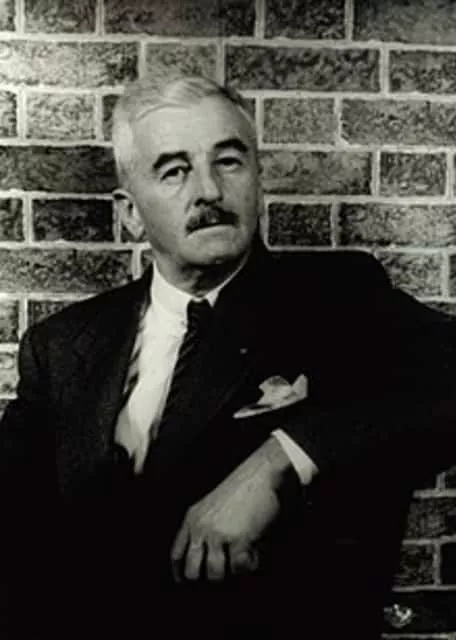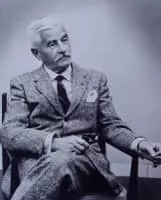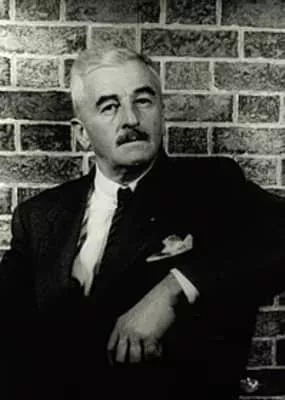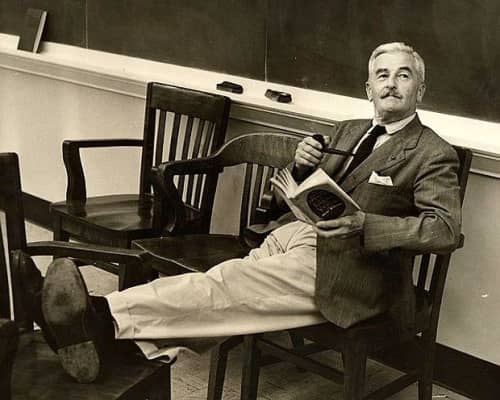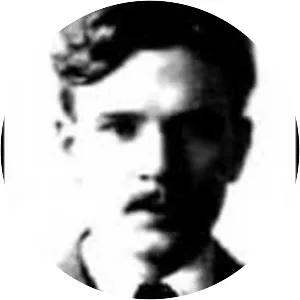
William Faulkner
| Use attributes for filter ! | |
| Gender | Male |
|---|---|
| Death | 63 years ago |
| Date of birth | September 25,1897 |
| Zodiac sign | Libra |
| Date of died | July 6,1962 |
| Died | Byhalia |
| Mississippi | |
| United States | |
| Short stories | A Rose for Emily |
| Barn Burning | |
| Dry September | |
| That Evening Sun | |
| Height | 165 (cm) |
| Job | Novelist |
| Screenwriter | |
| Education | University of Mississippi |
| Oxford High School | |
| University of Virginia | |
| Awards | Nobel Prize in Literature |
| Pulitzer Prize for Fiction | |
| National Book Award for Fiction | |
| American Academy of Arts and Letters Gold Medal for Fiction | |
| Spouse | Estelle Oldham |
| Children | Jill Faulkner |
| Born | New Albany |
| Mississippi | |
| United States | |
| Full name | William Cuthbert Falkner |
| Influences | James Joyce |
| Mark Twain | |
| Edgar Allan Poe | |
| William Shakespeare | |
| Herman Melville | |
| Siblings | John Faulkner |
| Dean Swift Faulkner | |
| Murry Charles "Jack" Faulkner | |
| Parents | Murry Cuthbert Falkner |
| Maud Butler | |
| Date of Reg. | |
| Date of Upd. | |
| ID | 402094 |
Light in August
Sanctuary
Collected Stories of William Faulkner
Go Down, Moses
The Hamlet
If I Forget Thee, Jerusalem
The Reivers
Sartoris
A Fable
The bear
Soldiers' Pay
Intruder in the Dust
Dry September
Pylon
Flags in the Dust
Knight's Gambit
That Evening Sun
The Mansion
portable Faulkner
The Town
These 13
Spotted Horses
Mosquitoes
Big woods
The Wishing Tree
The Faulkner reader
New Orleans Sketches
Three famous short novels
Uncollected stories of William Faulkner
A green bough
Essays, speeches & public letters
Red Leaves
Vision in spring
The Essential Faulkner
L'Arbre aux Souhaits
Uncle Willy and Other Stories
Miss Zilphia Gant
de Esta Tierra y Mas Alla
Marble Faun&green Bough
Dzikie palmy
Selected short stories
Faulkner at Nagano
Idyll in the desert
Notes on a horsethief
Mirrors of Chartres Street
Helen, a courtship
Faulkner at West Point
The Sound and the Fury
As I Lay Dying
A Rose for Emily
Absalom, Absalom!
To Have and Have Not
Two Soldiers
The Long, Hot Summer
The Story of Temple Drake
Mildred Pierce
As I Lay Dying
Gunga Din
Today We Live
The Sound and the Fury
Land of the Pharaohs
Submarine Patrol
The Tarnished Angels
The Arsonist
Drums Along the Mohawk
The Southerner
God Is My Co- Pilot
Slave Ship
Background to Danger
Deep Valley
Four Men and a Prayer
The Reivers
Sanctuary
Barn Burning
Tomorrow
Intruder in the Dust
Flesh
The Long Hot Summer
Air Force
Sutter's Gold
Old Man
The Long Hot Summer
William Faulkner Life story
William Cuthbert Faulkner was an American writer known for his novels and short stories set in the fictional Yoknapatawpha County, based on Lafayette County, Mississippi, where Faulkner spent most of his life.
Prince Harry book recalls trauma of Diana's death

... A clue to understanding Prince Harry s clear sense of unfinished business comes from a quote from US writer William Faulkner that s used to start a chapter: " The past is never dead...
Jean-Luc Godard: Nine things about the man who remade cinema

... Godard was a voracious reader on top of his love of cinema and the sheer weight of references can be bewildering, Barely 70 minutes long, Goodbye to Language, for example, packs in nods to abstract painter Nicolas de Staël, modernist US author William Faulkner and mathematician Laurent Schwartz...
How to sell the company, the 'unspeakable' sanitary napkins?
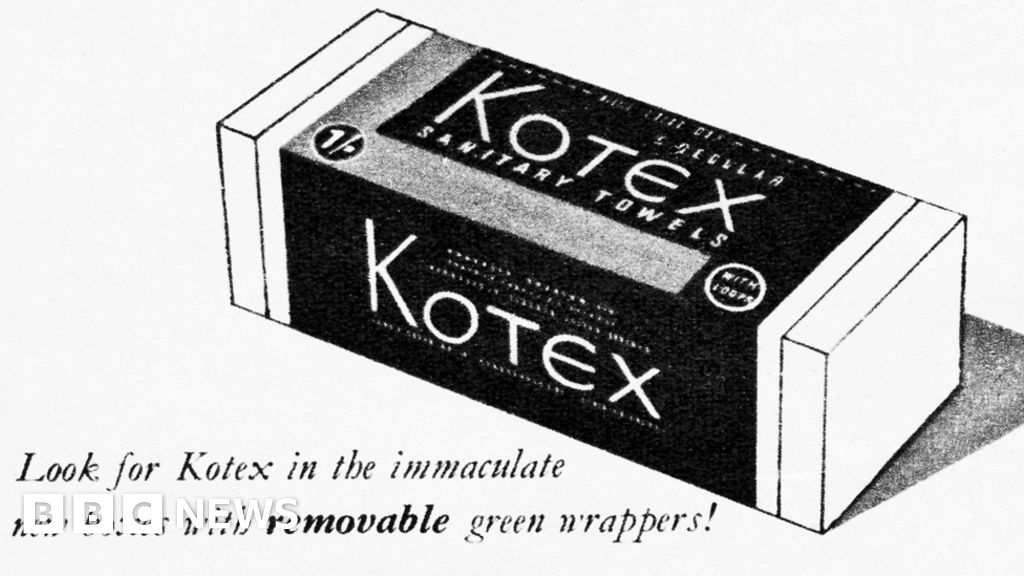
... The future Nobel literature prize winner William Faulkner lamented: I seem to be out of touch with the Kotex age here, that I can t seem to think of anything, me...
How to sell the company, the 'unspeakable' sanitary napkins?
"I wish someone would tell me what is Kotex. "So confused, said a young American man at a Dinner Party in the 1920s. No One would, of course. Kotex was a code-word - an obscure reference to Something that a mystery should be.
Kotex was - and remains - One of the most well-known brands of the menstrual cycle pad.
But , when Sharra Vostral writes in her book Under lock and key, One of the most important missions of menstrual products like pads, tampons, and cups is discretion: the rest of The World simply do not know whether a woman during Menstruation or not.
And the women have good reason to keep it quiet.
In 1868, the Vice-President of The American Medical Association warned doctors could not be trusted, during their monthly "disability".
Five years later, The American physician and sex educator Edward Clarke said, the girl should be removed from the classroom during their periods. It was expected to be demanding, to think that you and Menstruation at the same time.
The writer Eliza Duffey, reacted strongly to Dr. Clarke had no objection to women in strenuous house work during their periods. Maybe he just wanted to education for girls refuse? Maybe, in fact.
It was hardly surprising, women preferred, to The Details of your monthly cycle to itself, where a home-made approach.
highlights of the inventions, ideas and innovations that contributed to the economic world.
It is with the broadcast on the BBC World Service. You can find and or.
thought to have been made of wool, in Rome, of vegetable fibres in Indonesia, paper in Japan, grass in Africa, papyrus, reed, in Egypt, and ferns in Hawaii.
Historically, women would also shred Mode pads made of fabric, which often use wash and reuse. We know by now.
But in the late 19Th Century , the house made products have been replaced by goods produced in other parts of life, so Why Not in this case?
The Challenge was to advertise: How To and a product of the company to sell inexpressible considered?
In fact, The First recorded attempts signed to sell disposable pads date to the 1890s.
Johnson & Johnson produced and distributed "Lister's towels" in the United States in 1896, and "Hygiene wipes", from the German manufacturer Hartmann, have been advertised, at Harrods, in London, 1895.
But these products do not make much of an impact. It seems that most of the women found it cheaper or more comfortable or less embarrassed, had its own sanitary towels are made of what material you have on hand.
A major technological breakthrough came after The First World War , when The Paper mill Kimberly-Clark uses a new material called "cellucotton" to make bandages.
Cellucotton was made from wood pulp. It was much cheaper than cotton and much more absorbent.
At the end of The War , when Kimberly-Clark was on the search for new markets, he received letters from nurses saying they were with the cellucotton for Something other than bandages.
Clearly, it was a Chance. But it seemed to risky to: non-Johnson & Johnson's experience recommend, The Product may be too taboo to be successful?
Kimberly-Clark launched yet, the mysterious name "Kotex". It stands for "cotton texture", But , more importantly, the Young Men at the dinner-parties had no idea what is meant with "Kotex".
The new product caught on quickly. For decades, women had to find some independence and jobs in factories and offices.
in Spite of Dr Edward Clark concerns, you could think of and Menstruation at the same time, and they needed a convenient, disposable product. To everyone's surprise, Kimberly-Clark is a hit.
More things that the modern economy:The First detailed study of the growing menstrual technology market was in the year 1927, by Lillian Gilbreth, a pioneer in the application of scientific ideas from psychology and engineering to the economic problems of marketing, ergonomics and design.
she noticed the modern woman needs to get out and about. She stressed women wanted a discrete packaged product.
But while the products themselves were made to be used, secretly, soon there was nothing mysterious about the way they were marketed to you. The booming market, the manufacturer is encouraged to bombard consumers with advertising, even if euphemistic love.
Some of the men have been mystified in the 1920s; by The 1930S , some felt Under Siege .
The Future Nobel literature prize winner William Faulkner lamented: "I seem to be out of touch with 'the Kotex age' here, that I can't seem to think of anything, me. "
There are some nerves will take debt-to-Kotex advertising for your writer's block, But it says Something about how quickly the previously unutterable technology has had in the cultural mainstream.
Which was followed cellucotton pad, which in The 1930S by the commercial pad, patented in 1933 and marketed as "Tampax".
The First appeared soon after, in 1937, patented by a woman, Leona Chalmers Watson.
Then The War came. To help menstrual products have been marketed, as a way, the participation of women in The War . A Kotex ad showed a teenager poiing, the broom and mop abandoned.
"Who would have thought that she would be a deserter from a dust MOP and a few dishes, if the mother is Counting On you?"
These Days , you are already registered, the culture.
From a Western perspective, the old feeling of embarrassment is ridiculous - a 21St Century advertising have to ride over the tropics from an earlier age, of blue liquids in sterile laboratories, interspersed with shots of women in tight white shorts white horses.
But in many parts of The World , it's not a joke.
Consider the case rather than the dirty cloth, she was use to.
"I wouldn't use to clean it with my scooter," he said.
He began experiments to produce a simple pad Machine - Something both jobs and cheap pads for women in India could bring.
Arunachalam Muruganantham , the story appeared in the 2013 documentary Menstrual ManHis wife, Shanthi, approached him. So also his widowed mother. What he did was just too humiliating.
Mr Muruganantham is now celebrated for his Invention - and, Yes, Shanthi came back. But his setbacks give you an insight to how powerful the Stigma remains in many parts of The World .
The Stigma is One reason why - according to the United Nations Educational, Scientific and Cultural Organization (Unesco ) - Dr. Edward Clark approved in may, But this is a serious matter: after falling behind, some of the girls to fall out completely.
It is not only the shame - there is also a lack of access to clean water, and a lockable Laundry rooms.
And of course there is the issue of Mr Muruganantham was trying to solve: many Young Women can simply not afford, the menstrual cycle of the products, the other for, of course, to take.
William Faulkner might have felt alienated from the Kotex age - But almost a century later, many women always wait to arrive to the age.
The author writes the Financial Times Undercover Economist column. the show is on the BBC World Service. You can find and or
periods, period poverty, women
Source of news: bbc.com
